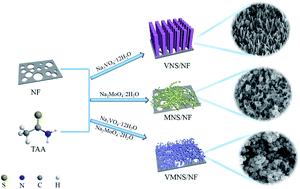The controlled synthesis of V-doped MoS2-NixSy hollow nanospheres and their electrocatalytic performance in hydrogen evolution reaction†
Abstract
Transitional bimetallic sulfides have attracted extensive attention for electrocatalytic hydrogen evolution owing to their abundant reserves and low price. However, the rational design and the controlled synthesis of transitional bimetallic sulfide-based electrocatalysts for hydrogen production is still a big challenge. In this work, we report the synthesis of V-doped MoS2-NixSy/NF (VMNS/NF-β, β = nV : nMo) hollow nanospheres by an in situ one-pot method, and the electrocatalytic performance of the nanospheres can be optimized by adjusting the amount of vanadium doping. The introduction of the V source and Mo source can promote the formation of typical hollow nanospheres and affect the crystal phases of NiS. V has the advantages of valence diversity and unique electronic structure as well as the synergistic effect of bimetallic sulfide to enhance the electrocatalytic performance of the whole system. The optimized VMNS/NF (nV : nMo = 1 : 1) showed excellent HER performance in 1 M KOH solution at room temperature. At the current density of 10 mA cm−2, it has a low overpotential of 68 mV and maintains good stability at a current density of 32 mA cm−2 for 24 h.



 Please wait while we load your content...
Please wait while we load your content...